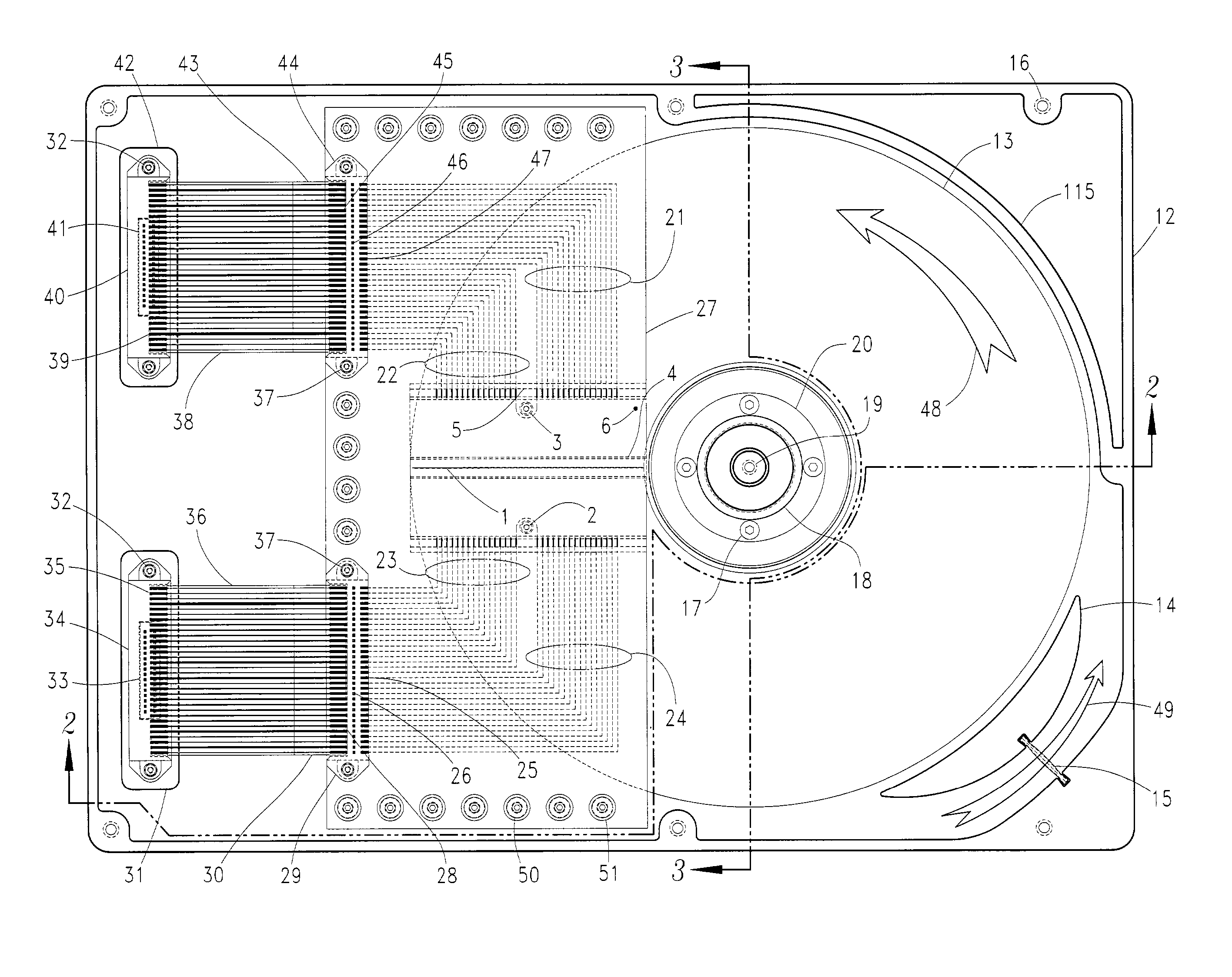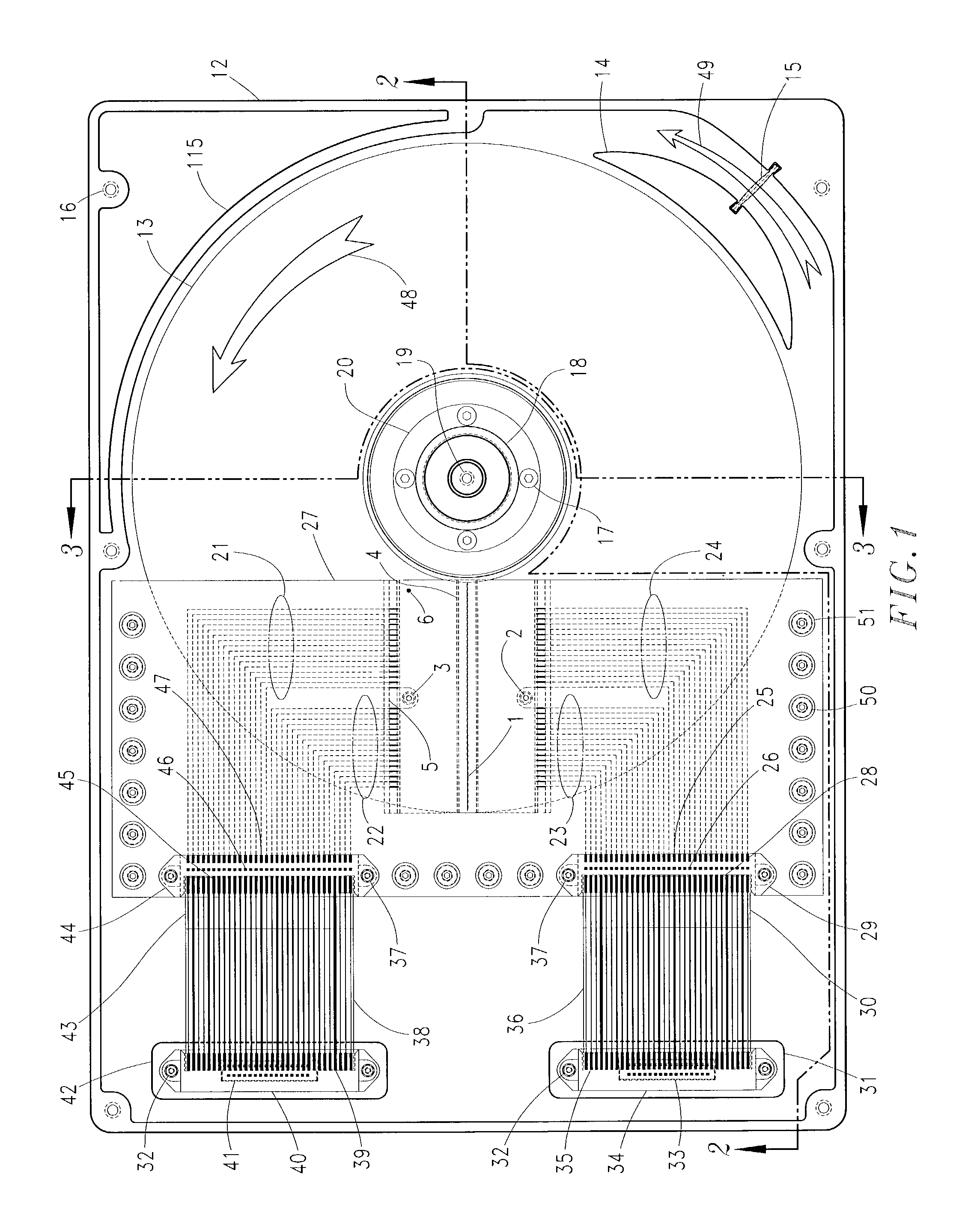Furthermore, another issue confronting the designer of a hard disk drive
system is data-head positioning and data-
block transfer-rates.
Consequently, when
servo-information is embedded on a data-surface formatted for Zoned-Data-Recording, several complications may arise in the reliably of providing robust
servo-head positioning information.
Typically, if the servo-information is recorded at the same data-rate while in positional relationship with the recorded data-blocks, as has been conventionally employed in prior art, servo-architecture is normally complex enough to switch data-rates and servo-positions.
However, if regularly spaced servo-information were radially placed across data-storage disk-platter data-surfaces, while splitting some of the data-fields, located on the aforementioned data-surfaces, into segments, data-zones, when crossed-over, could cause serious complications to arise when trying to read each `Split
Data Field` as a single data-block.
Furthermore, the before mentioned disk-platter's rotational velocity must be constantly monitored and carefully maintained at a predetermined
constant angular velocity for the aforesaid `Split
Data Field` scheme to function properly; therefore, adding additional complexity to the servo-
tracking system.
Consequently, this causes a supervisory
microcontroller intervention to occur for every data-sector being processed.
However, some hard disk drive designs do not use, or normally include within their designs, the added complication of `Zoned Data-Recording` and `Split Data-Fields`.
This leads, however, to tremendous levels of
bus-traffic control between the supervisory
microcontroller and a
Disk Controller's Data Sequencer during read-data and / or write-data disk-operations.
However, during host-requested Phase-Change Microhead Array
Chip Hard Disk Drive's disk-operations mechanical movements of the Phase-Change Microhead Array Chips'
laser-
diode microheads, from one
concentric cylinder / track location to another is unnecessary.
Further, during a read-data or a write-data disk-operation, and in case of errors, a `Sector-ID` is neither read nor corrected, which increases the overall data
throughput for the hard disk drive.
Consequently, the `average-seek-time` bench-mark ratings for any flying-head (i.e., Phase-Change or conventional magnetic) hard disk drive design would be easily challenged by any hard disk drive design using the Phase-Change Microhead Array
Chip approach to its hard disk drive design.
Furthermore, about 60% of all conventional flying-head hard disk drive fatal-error crashes (i.e., sometimes called catastrophic hard disk drive failure) are catastrophic, and typically are the result of Rotary Voice-Coil and / or Spindle-Motor mechanical malfunctions or failures.
When examining this problem further, we find that flying-heads, in striving to maintain today's critical flying-height distance of 0.5- to 2.5-.mu.m above disk-platter data-surfaces on what is sometimes called an `air-bearing`, the before mentioned flying-heads can be caused to easily make physical contact with data-surfaces, for example during a catastrophic hard disk drive
crash, which will always result in
data loss (i.e., sometimes called catastrophic
data loss).
In fact, within a conventional rotary positioned flying-head hard disk drive design, a head-slider's
flight distance, which is today normally 0.5- to 2.5-.mu.m, would be difficult, if not impossible to achieve, were it not for the aerodynamic design of current flying-head head-sliders and the air-bearings that they produce.
Furthermore, catastrophic data-loosing hard disk drive crashes most often occur when a Spindle-Motor's power supply fails, or the hard disk drive, during a read-data or write-data disk-operation, is suddenly shaken or dropped, while the hard disk drive's head-stack
assembly has not been properly repositioned into an innermost disk-platter area (i.e., sometimes called the head-stack
parking area), but remains located over a data-surface when any of the malfunctions mentioned occurs.
Consequently, during a power-supply failure a hard disk drive's Spindle-Motor will lose its
momentum and begin to spin down causing the head-slider air-bearings to decay, where they can no longer maintain the
aerodynamic lift necessary for maintaining the head-slider's flight.
Therefore, a conventional flying-head hard disk drive's head-stack
assembly, not being repositioned into said head-stack
parking area, and being subject too complete loss of head-slider air-bearings, the before mentioned hard disk drive flying-heads will make physical contact with the before mentioned disk-platter data-surfaces, ultimately crashing into the data-sector areas located on the aforesaid hard disk drive's data-surfaces, destroying any previously recorded data stored therein.
Nevertheless, whatever the root-cause might be the end-result is always the same, hard disk drive crashes and severe data-loss.
 Login to View More
Login to View More  Login to View More
Login to View More 


